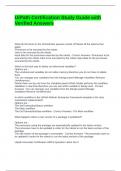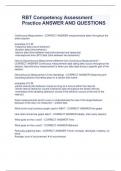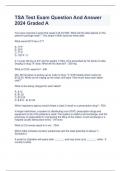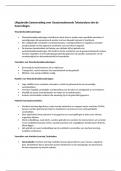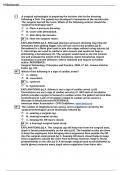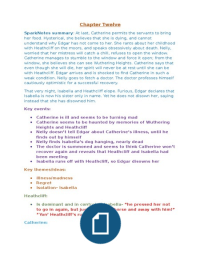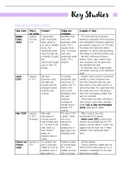Biology notes for assessment 1:
Prokaryotic cells and eukaryotic cells have a cell-surface (plasma) membrane that
separates the inside of the cell from its environment.
The plasma membrane is made from a phospholipid bilayer. It is a selective barrier that
controls the movement of substances in and out of the cell. E.g. oxygen, water, hormones
and CO2. A phospholipid is a lipid molecule with glycerol, two fatty acid chains, and a
phosphate-containing group. Plasma membranes have proteins and cholesterol embedded
in them. These proteins can act as receptors. This means that the cell can respond to the
external environment of the cell. Waste products (e.g. carbon dioxide and ammonia) leave
the cell by passing through the plasma membrane. Plasma membranes have proteins
and cholesterol embedded in them. The proteins can act as receptors. This means that the
cell can respond to its external environment.
Structure of the cytoplasm:
Cytoplasm is made up of organelles suspended in the gel-like cytosol. 70% of the cytoplasm
is made up of water. The cytoplasm also contains proteins, sugars, ions and fatty acids.
Many metabolic reactions take place in the cytoplasm. Different organelles perform specific
functions within the cytoplasm. It is important to remember that organelles are parts of a
cell. Organelles are NOT cells even though they often surrounded by membranes.
The nucleus:
Nuclear envelope: double membrane (outer membrane continuous with RER). Both inner
and outer membrane are phospholipid, bilayers.
Nucleolus: production of rRNA and assembly of ribosomes. Nuclear pores: allow movement
in and out e.g. mRNA out and hormones that regulate gene expression in. and we can see
that the outer membrane of that nuclear envelope is continuous or carries on straight into
this blue organelle called the rough ER. Inside the nucleus is a dark area, a more dense area
called the nucleolus. This is where ribosomal (RNA) is synthesised and ribosomes are
assembled before they leave the nucleus through the nucleus pores. And then these strands
that ou can see inside the nucleus are chromatin and the nucleus’s job is to enclose the
chromatin. Encloses the chromatin (DNA wrapped around histones) e.g., if transcription
has taken place inside the nucleus, the messenger RNA will need to exit the nucleus to travel
to the cytoplasm and it does that through the nuclear pores and the main job of the nucleus
is the enclosure of the chromatin.
Mitochondria and chloroplasts:
Mitochondria are oval-shaped, double-membrane organelles that have their own ribosomes
and DNA. Each membrane is a phospholipid bilayer embedded with proteins. The inner
layer of the membrane has folds called cristae. The area surrounded by the folds is called
the mitochondrial matrix. The mitochondrial matrix contains enzymes used for respiration.
Mitochondria make ATP via aerobic respiration.
Muscle cells have a very high concentration of mitochondria because they are highly active
and need a lot of energy to keep the body moving. Chloroplasts have their own DNA,
ribosomes and have inner and outer membranes. The space enclosed by the inner
membrane contains a set of interconnected and stacked fluid-filled membrane sacs called
thylakoids. Each stack of thylakoids is called a granum (plural = grana). Grana are linked by
lamellae. Lamellae are flat, thin parts of thylakoid membrane. The fluid enclosed by the
, inner membrane that surrounds the grana is called the stroma. Photosynthesis is the series
of reactions that use carbon dioxide, water and light energy to make glucose and oxygen.
This process happens in chloroplasts and allows plants to make their own food (e.g. sugars).
Chloroplasts are found in plant and algal cells but not in animal or fungal cells.
The Golgi apparatus and Golgi vesicles:
The Golgi apparatus releases Golgi vesicles. Lysosomes are a special type of Golgi vesicle.
The Golgi apparatus is a series of flattened membranous sacs. Transport vesicles form at the
endoplasmic reticulum and fuse with the Golgi apparatus.
The transport vesicles empty proteins and lipids into the lumen of the Golgi apparatus. As
the proteins and lipids travel through the Golgi, they are sorted, packaged and tagged so
that they can be sent to the right place. Golgi vesicles are membrane-bound, fluid-filled
vesicles located in the cytoplasm. They are small, round and are seen in a high density near
the edges of the sacs.
Lysosomes are a type of Golgi vesicle. Golgi vesicles store and transport modified proteins
and lipids from the Golgi apparatus to target cells. Lysosomes are a special type of Golgi
vesicle. They contain enzymes called lysozymes.
Lysozymes aid the breakdown of proteins, polysaccharides, lipids, nucleic acids and old
organelles.
Ribosomes and the endoplasmic reticulum:
Proteins are made in ribosomes. Proteins may then be folded and processed by the rough
endoplasmic reticulum (RER). The smooth endoplasmic reticulum makes and processes
lipids. Ribosomes can be free floating in the cytoplasm or attached to the cytoplasmic side of
the endoplasmic reticulum (ER). Ribosomes are very small organelles made of protein
subunits. This means that ribosomes are not covered by a membrane. Ribosomes are in
charge of protein synthesis. Protein synthesis is an essential function of all cells. This is why
ribosomes are found in practically every cell. The ER is a series of interconnected
membranous sacs and tubules. The membrane of the ER is a phospholipid bilayer
embedded with proteins. The smooth ER (SER) membrane has no ribosomes but the rough
ER (RER) membrane has many ribosomes on its surface. The RER is responsible for
processing and folding proteins. The SER is responsible for making and processing lipids.
Cell wall and cell vacuole
The cell wall is a structure external to the plasma membrane. Cell vacuoles are found in
plant cell cytoplasm. The cell wall is a rigid covering that protects the cell. Plant, fungal and
algal cells all have cell walls. The major organic molecule in fungal cell walls is chitin. Plant
and algal cell walls are made of cellulose. Cellulose is a polysaccharide made up of glucose
units. The cell wall provides structural support and gives shape to the cell. Plant cells each
have a large central vacuole that occupies most of the area of the cell. These vacuoles are
surrounded by a membrane called the tonoplast and contain a weak solution of salts and
sugars called cell sap. Cell vacuoles are found in the cytoplasm of plant cells but are NOT
present in animal cells. The central vacuole allows the cell to remain rigid. When the central
vacuole holds more water, the vacuole pushes against the cell wall and pressure is
maintained. This stops the plant from wilting.
The vacuole also isolates certain chemicals that are unwanted by the rest of the cell.
Prokaryotic cells and eukaryotic cells have a cell-surface (plasma) membrane that
separates the inside of the cell from its environment.
The plasma membrane is made from a phospholipid bilayer. It is a selective barrier that
controls the movement of substances in and out of the cell. E.g. oxygen, water, hormones
and CO2. A phospholipid is a lipid molecule with glycerol, two fatty acid chains, and a
phosphate-containing group. Plasma membranes have proteins and cholesterol embedded
in them. These proteins can act as receptors. This means that the cell can respond to the
external environment of the cell. Waste products (e.g. carbon dioxide and ammonia) leave
the cell by passing through the plasma membrane. Plasma membranes have proteins
and cholesterol embedded in them. The proteins can act as receptors. This means that the
cell can respond to its external environment.
Structure of the cytoplasm:
Cytoplasm is made up of organelles suspended in the gel-like cytosol. 70% of the cytoplasm
is made up of water. The cytoplasm also contains proteins, sugars, ions and fatty acids.
Many metabolic reactions take place in the cytoplasm. Different organelles perform specific
functions within the cytoplasm. It is important to remember that organelles are parts of a
cell. Organelles are NOT cells even though they often surrounded by membranes.
The nucleus:
Nuclear envelope: double membrane (outer membrane continuous with RER). Both inner
and outer membrane are phospholipid, bilayers.
Nucleolus: production of rRNA and assembly of ribosomes. Nuclear pores: allow movement
in and out e.g. mRNA out and hormones that regulate gene expression in. and we can see
that the outer membrane of that nuclear envelope is continuous or carries on straight into
this blue organelle called the rough ER. Inside the nucleus is a dark area, a more dense area
called the nucleolus. This is where ribosomal (RNA) is synthesised and ribosomes are
assembled before they leave the nucleus through the nucleus pores. And then these strands
that ou can see inside the nucleus are chromatin and the nucleus’s job is to enclose the
chromatin. Encloses the chromatin (DNA wrapped around histones) e.g., if transcription
has taken place inside the nucleus, the messenger RNA will need to exit the nucleus to travel
to the cytoplasm and it does that through the nuclear pores and the main job of the nucleus
is the enclosure of the chromatin.
Mitochondria and chloroplasts:
Mitochondria are oval-shaped, double-membrane organelles that have their own ribosomes
and DNA. Each membrane is a phospholipid bilayer embedded with proteins. The inner
layer of the membrane has folds called cristae. The area surrounded by the folds is called
the mitochondrial matrix. The mitochondrial matrix contains enzymes used for respiration.
Mitochondria make ATP via aerobic respiration.
Muscle cells have a very high concentration of mitochondria because they are highly active
and need a lot of energy to keep the body moving. Chloroplasts have their own DNA,
ribosomes and have inner and outer membranes. The space enclosed by the inner
membrane contains a set of interconnected and stacked fluid-filled membrane sacs called
thylakoids. Each stack of thylakoids is called a granum (plural = grana). Grana are linked by
lamellae. Lamellae are flat, thin parts of thylakoid membrane. The fluid enclosed by the
, inner membrane that surrounds the grana is called the stroma. Photosynthesis is the series
of reactions that use carbon dioxide, water and light energy to make glucose and oxygen.
This process happens in chloroplasts and allows plants to make their own food (e.g. sugars).
Chloroplasts are found in plant and algal cells but not in animal or fungal cells.
The Golgi apparatus and Golgi vesicles:
The Golgi apparatus releases Golgi vesicles. Lysosomes are a special type of Golgi vesicle.
The Golgi apparatus is a series of flattened membranous sacs. Transport vesicles form at the
endoplasmic reticulum and fuse with the Golgi apparatus.
The transport vesicles empty proteins and lipids into the lumen of the Golgi apparatus. As
the proteins and lipids travel through the Golgi, they are sorted, packaged and tagged so
that they can be sent to the right place. Golgi vesicles are membrane-bound, fluid-filled
vesicles located in the cytoplasm. They are small, round and are seen in a high density near
the edges of the sacs.
Lysosomes are a type of Golgi vesicle. Golgi vesicles store and transport modified proteins
and lipids from the Golgi apparatus to target cells. Lysosomes are a special type of Golgi
vesicle. They contain enzymes called lysozymes.
Lysozymes aid the breakdown of proteins, polysaccharides, lipids, nucleic acids and old
organelles.
Ribosomes and the endoplasmic reticulum:
Proteins are made in ribosomes. Proteins may then be folded and processed by the rough
endoplasmic reticulum (RER). The smooth endoplasmic reticulum makes and processes
lipids. Ribosomes can be free floating in the cytoplasm or attached to the cytoplasmic side of
the endoplasmic reticulum (ER). Ribosomes are very small organelles made of protein
subunits. This means that ribosomes are not covered by a membrane. Ribosomes are in
charge of protein synthesis. Protein synthesis is an essential function of all cells. This is why
ribosomes are found in practically every cell. The ER is a series of interconnected
membranous sacs and tubules. The membrane of the ER is a phospholipid bilayer
embedded with proteins. The smooth ER (SER) membrane has no ribosomes but the rough
ER (RER) membrane has many ribosomes on its surface. The RER is responsible for
processing and folding proteins. The SER is responsible for making and processing lipids.
Cell wall and cell vacuole
The cell wall is a structure external to the plasma membrane. Cell vacuoles are found in
plant cell cytoplasm. The cell wall is a rigid covering that protects the cell. Plant, fungal and
algal cells all have cell walls. The major organic molecule in fungal cell walls is chitin. Plant
and algal cell walls are made of cellulose. Cellulose is a polysaccharide made up of glucose
units. The cell wall provides structural support and gives shape to the cell. Plant cells each
have a large central vacuole that occupies most of the area of the cell. These vacuoles are
surrounded by a membrane called the tonoplast and contain a weak solution of salts and
sugars called cell sap. Cell vacuoles are found in the cytoplasm of plant cells but are NOT
present in animal cells. The central vacuole allows the cell to remain rigid. When the central
vacuole holds more water, the vacuole pushes against the cell wall and pressure is
maintained. This stops the plant from wilting.
The vacuole also isolates certain chemicals that are unwanted by the rest of the cell.

